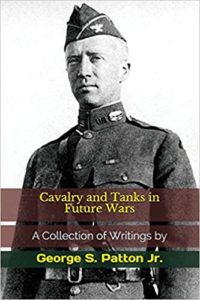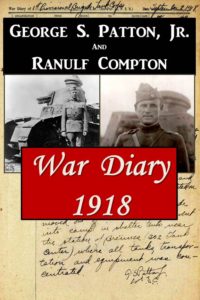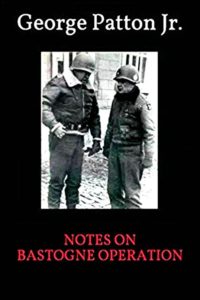Cavalry and Tanks in Future Wars is a collection of articles written by George S. Patton, Jr., in which he applies his diverse experiences as a cavalry officer chasing Pancho Villa on the Mexican Border and as a tank commander in 1918 France to defend the continued relevance of cavalry and tanks in future wars. Available in paperback or Kindle ebook here Amazon
 Saber Exercise 1914 Training Manual in Swordsmanship, was written by George S. Patton, Jr. the year after the War Department approved his radical redesign of the cavalry saber. The redesign necessitated a fundamental change in mounted and dismounted saber techniques—all of which is explained in this manual. Paperback and Kindle ebook available here Amazon
Saber Exercise 1914 Training Manual in Swordsmanship, was written by George S. Patton, Jr. the year after the War Department approved his radical redesign of the cavalry saber. The redesign necessitated a fundamental change in mounted and dismounted saber techniques—all of which is explained in this manual. Paperback and Kindle ebook available here Amazon
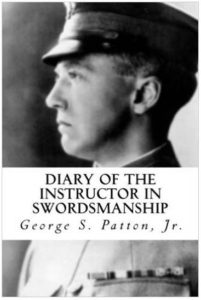
Diary of the Instructor in Swordsmanship is the second training manual written by George S. Patton, Jr. to teach proper “Patton Saber” techniques for mounted and dismounted cavalry engagements. His first training manual, Saber Exercise 1914, covers general tactics and techniques while this subsequent manual supplements the first by providing more detailed instruction. Purchase paperback here Amazon and Kindle ebook here Amazon
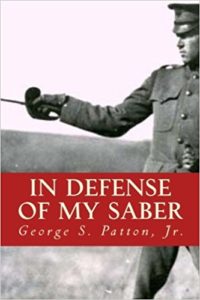
In Defense of My Saber, a collection of articles written by George S. Patton, Jr. between 1913 and 1917, offers a window into the brief life span of his invention, the “Patton Saber”–from the first glory days when it was adopted by the War Department as standard issue for the cavalry to its ultimate demise into irrelevance unable to compete with the big guns of World War I. Included are some fascinating history lessons by Patton on the development of the sword and saber and how the shape of each determined its purpose and tactics. Available in paperback and Kindle ebook here Amazon
Mexican Punitive Expedition Diary by George S. Patton Jr.
Pancho Villa attacked Columbus, New Mexico in March of 1916. With several thousand men, he plundered the tiny desert town, set fire to buildings and killed sixteen Americans. After the brazen Columbus attack, President Woodrow Wilson deployed a punitive expedition led by General John J. Pershing into Mexico to capture Villa. Pershing assumed it would be a simple task to capture Pancho Villa and quickly return to the states. But he was wrong. The extreme Mexican climate, topography and anti-American sentiment of the people and its military posed tremendous challenges for American forces. Lieutenant George S. Patton Jr. deployed as an aide to Pershing. One of his duties was keeping the official expedition diary, which we have published in this book. But that is only part of the story. There exist not one but three expedition diaries written by Patton. Why that occurred and how we merged them—for the first time ever—into one consolidated whole is also detailed in this book. The expedition never captured Pancho Villa, but it was still a successful campaign. The United States was about to enter World War I. This Mexican foray provided real-world experience for the coming fight. There were also important firsts: it was the first time airplanes were deployed into an American military operation; the first time trucks were utilized for logistical support, and the first motorized assault was conducted in the American military by none other than George S. Patton Jr. All detailed in this diary. Purchase at Amazon here. Mexican Punitive Expedition Diary: Patton Jr., George S., Rohde, Aleksandra M., Rohde, Aleksandra M., Rohde, Aleksandra M.: 9781941656655: Amazon.com: Books
Purchase our companion book by Aleksandra Rohde, Once Upon a Time in Mexico, which chronicles the Mexican Punitive Expedition within the larger context of the Mexican Revolution of 1910-1920. Once Upon a Time in Mexico: Rohde, Aleksandra Miesak: 9781941656648: Amazon.com: Books
War Diary 1918 by George S. Patton Jr. The War Department required commanders to keep a daily war diary to capture in detail the operations of their units on the Western Front of the Great War. George S. Patton Jr. commanded the first American tank brigade in World War I. Ranulf Compton was one of Patton’s battalion commanders. War Diary 1918 is the verbatim transcription of Patton’s and Compton’s War Diaries during the last months of the war, including the Battle of St. Mihiel and the Meuse-Argonne Offensive. Adding to the historical value of these diaries is the fact that after Patton was wounded the first day of the Meuse-Argonne Offensive, Sereno E. Brett, the commander of Patton’s other tank battalion, assumed command of Patton’s brigade and Compton was put in charge of “all the tanks at the front.” Patton, a graduate of West Point, was a career Army officer. Because Patton played a pivotal role in the development of the early Tank, his career was closely linked to the success of tanks on the battlefield, making him especially eager to demonstrate their effectiveness. Compton, a Harvard man who would return to private life after the war, did not share the same predilection for tanks. While Patton in his daily diary entries tended to gloss over some of the challenges of operating tanks in the fog and mud of war, Compton was more candid in his diary comments. While Patton went on to further fame and glory, Compton went back to finish his New York Guard obligations and settle into a comfortable private life, first serving as a U.S. Congressman representing the State of Connecticut and then owning a broadcasting company. But as an eyewitness to early tanks in battle, Compton left behind a valuable piece of unvarnished history regarding early tank warfare. Available online at Amazon
George Patton describes the execution of his bold plan to rescue American troops surrounded by German forces at Bastogne, the pivotal battle of World War II. The German push through the Ardennes was Hitler’s last chance for victory. He might have succeeded had it not been for Patton’s military brilliance and the dogged determination and bravery of his Third Army. Read the full story here, written in Patton’s own words.
Purchase your copy of Notes on Bastogne Operation at Amazon
